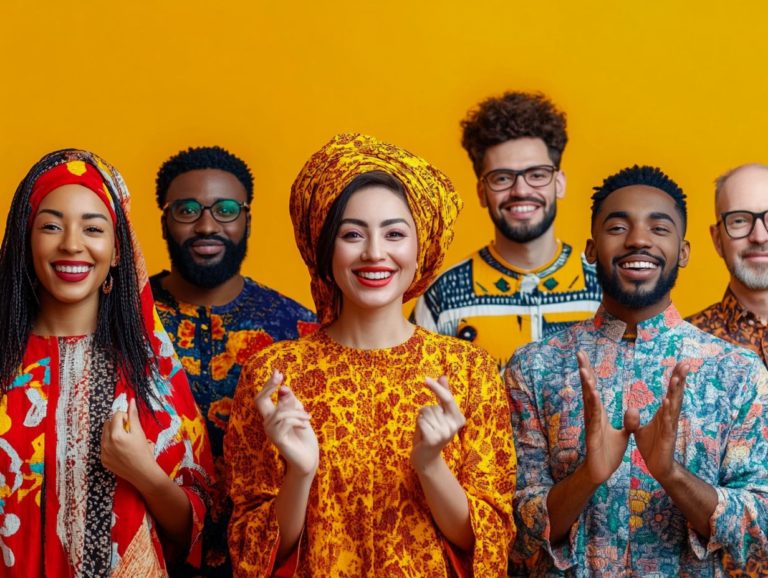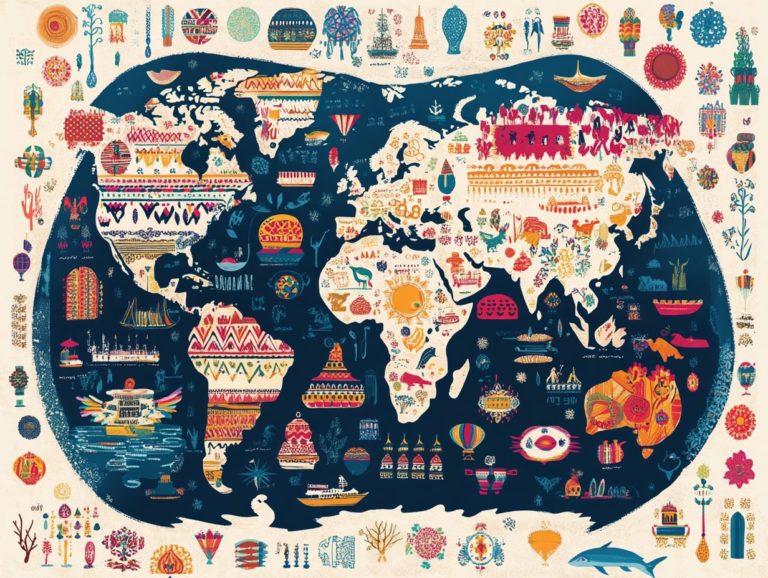the influence of art on language and communication
Art and language are two powerful forms of expression that intertwine in truly fascinating ways. This article invites you on an exciting journey to explore the dynamic relationship between these mediums, revealing how art not only shapes vocabulary but also enhances both verbal and nonverbal communication.
You will discover the crucial role art plays in language development, its therapeutic benefits, and how historical and cultural influences have evolved in tandem with language itself.
Practical techniques for harnessing art to improve your communication skills will also be shared. Prepare to uncover the profound impact art has on the ways you connect and express yourself.
Contents
- Key Takeaways:
- The Relationship Between Art and Language
- How Art Shapes Language and Communication
- The Role of Art in Language Development
- The Evolution of Language and Art
- Using Art to Enhance Communication
- Frequently Asked Questions
- How does art influence language and communication?
- What are some examples of how art can impact language and communication?
- In what ways can art improve language and communication skills?
- How does the use of art in therapy impact language and communication?
- Can art be used as a tool for language and communication intervention?
- Are there any potential negative impacts of art on language and communication?
Key Takeaways:

Art and language have a strong relationship, with art influencing the development and evolution of language throughout history.
Art can shape language and communication by expanding vocabulary and enhancing expression. It also influences nonverbal communication.
Art is a powerful tool for learning languages and improving communication skills.
The Relationship Between Art and Language
The intricate relationship between art and language offers you a profound avenue for human expression, transcending traditional boundaries. It fosters rich dialogues that capture the nuances of culture and emotion.
Through various artistic mediums, narratives come together, inviting you to engage in a transformative exploration of shared experiences and personal reflections.
Artists utilize language not merely as a communication tool but as a medium that evokes deep connections. They craft a space where the complexities of human identities and social dynamics can be critically examined and understood.
Exploring the Connection
Exploring the connection between art and language unveils the countless ways these forms of expression intertwine to enrich your understanding of culture. Art acts as a potent visual language, conveying emotions and narratives that resonate profoundly with you.
Imagine a single painting that encapsulates an entire history, narrating tales of struggle, triumph, and identity without uttering a single word. Cultural narratives continually shape artistic expression, as evident in Indigenous art, which reflects traditions and ancestral stories through its vibrant imagery.
Art and language work together in creativity. Literature often ignites visual interpretations, just as sculptures or paintings can inspire poetry. Together, these mediums cultivate a deeper comprehension of shared human experiences, forging connections that transcend linguistic barriers and delve into universal themes.
How Art Shapes Language and Communication
Art profoundly influences your language and communication, introducing strong visuals and performance styles that elevate expression beyond conventional verbal forms.
This dynamic interplay enables you to delve deeper into themes and emotions, challenging established conventions and enriching how you convey messages and interpret narratives.
Impact on Vocabulary and Expression
The impact of art on your vocabulary and expression is strikingly clear. Visual narratives and artistic themes can inspire new words and phrases, fundamentally shaping how you communicate your feelings and experiences.
Take movements like Surrealism, for example. They didn’t just challenge traditional perceptions of reality; they also introduced a rich lexicon filled with dream-like imagery and metaphor.
Artists such as Salvador Dal crafted phrases that stir intense emotional responses, adding a profound layer of depth to cultural dialogue. Similarly, the bold geometric forms of Cubism, an art movement that breaks subjects into geometric shapes, championed by artists like Pablo Picasso, have generated terms that convey ideas of fragmentation and simultaneity, mirroring the modernist perspective of existence.
These artistic expressions not only enhance your language but also open up new pathways for emotional communication across diverse cultural landscapes, giving you the power to articulate complex feelings in fresh and innovative ways.
Influence on Nonverbal Communication

Art profoundly shapes nonverbal communication by using visual elements to express emotions and tell stories without words.
Performance art and visual arts offer immersive experiences. These resonate deeply within you. The vibrant colors, dynamic movements, and unique materials often stir feelings of joy, sorrow, or contemplation. They allow you to connect with others on a genuine emotional level, going beyond regular limits.
This powerful form of communication invites personal interpretation, fostering a shared understanding among diverse groups. The emotional depth conveyed through these mediums can enhance social dynamics, sparking dialogue and reflection in ways that spoken words sometimes fail to achieve.
The Role of Art in Language Development
Art plays a vital and exciting role in how we develop language skills, acting as a transformative tool that enriches learning and sharpens communication skills for various audiences.
By engaging with creative mediums, you can delve into language in immersive ways, fostering connections that go beyond traditional educational and social interaction methods.
Art as a Tool for Learning Language
Art stands as an invaluable tool in your language-learning journey, offering experiences that truly engage you and facilitate a deeper understanding and retention of the language.
By incorporating visual aids like paintings, drawings, and sculptures, you can create vibrant contexts for enriching your words.
Storytelling through illustrated books encourages you to visualize scenarios, enhancing your comprehension and fostering expressive language skills. Engaging in interactive projects, like creating a mural or participating in a theater production, promotes collaboration and allows you to practice the language in a dynamic setting.
These activities nurture your creativity and build your confidence in using the language authentically. Ultimately, they enrich your overall educational experience.
Art Therapy and Communication
Art therapy is a strong way to improve communication and emotional expression, especially for those who encounter language barriers or struggle to articulate their feelings.
By engaging with various artistic mediums such as painting, drawing, or sculpture you can often go beyond traditional linguistic limitations. This allows for a richer, more nuanced depiction of your inner experiences.
Creating visual representations of your emotions deepens your understanding of what you’re feeling and encourages storytelling that nurtures your personal narrative.
Research highlights that immersing yourself in art therapy can lead to significant improvements in communication skills, revealing its potential for transformative emotional healing.
Case studies illustrate that children with Autism Spectrum Disorder have made remarkable strides in social interactions and self-expression through structured art therapy sessions.
The Evolution of Language and Art
The evolution of language and art presents a captivating journey, intricately woven with historical and cultural influences.
These elements have profoundly shaped human communication and artistic expression throughout the ages, revealing their deep interconnectedness in reflecting the human experience.
Historical and Cultural Influences

Historical and cultural influences have significantly shaped the evolution of both art and language, molding the ways you communicate and express yourself.
From the Renaissance s revival of classical ideals to the swift changes of the industrial era, each period has introduced distinct shifts in artistic expression and linguistic innovation.
These transformations often mirror the prevailing societal values. For example, movements like Romanticism celebrated individualism and emotional depth, while modernism favored abstraction and experimentation.
Linguistic developments such as the adoption of new words and idioms reflect contemporary social dynamics, shaping collective identities.
Together, these artistic and linguistic advancements create a rich tapestry of human identity, revealing just how deeply intertwined your expressions are with the cultural contexts from which they emerge.
Using Art to Enhance Communication
Using art enhances communication. It involves practical applications and techniques.
These approaches bridge language barriers. They foster understanding among diverse audiences.
Practical Applications and Techniques
Practical applications and techniques in using art for communication encompass various strategies aimed at enhancing engagement and fostering understanding across cultures. One particularly compelling method is visual storytelling, giving you the power to share narratives through striking imagery. Picture an exciting community mural project in a diverse urban neighborhood that unites artists and residents to depict their shared history.
This collaboration cultivates local pride and ignites meaningful dialogue among participants. Interactive art projects, like workshops where you create artwork alongside others, have proven effective in bridging cultural gaps, allowing for personal expression that transcends language barriers.
Exhibitions inviting audience participation, such as the acclaimed The Obliteration Room by Yayoi Kusama, engage you in a unique way. They encourage contributions that foster a sense of belonging and connection to the artwork and to one another.
Frequently Asked Questions
How does art influence language and communication?
Art has a significant influence on language and communication, as it allows for the expression of complex emotions, ideas, and concepts that may be difficult to convey through words alone. Through various forms of art, individuals can communicate and connect with others on a deeper level.
What are some examples of how art can impact language and communication?

One example is how visual art, such as paintings and sculptures, can convey a story or message without using words. Performing arts, like theatre or dance, utilize body language and nonverbal cues to communicate meaning. Art also preserves and shares cultural traditions, enhancing cross-cultural communication.
In what ways can art improve language and communication skills?
Engaging with art helps individuals develop their language and communication skills by encouraging creativity, critical thinking, and empathy. Art promotes active listening and observation, essential components of effective communication.
How does the use of art in therapy impact language and communication?
The use of art in therapy has been shown to improve language and communication skills in individuals with speech or language disorders, as well as those with mental health issues. Art therapy provides a nonverbal mode of expression, allowing individuals to communicate and process their emotions in a safe and supportive environment.
Can art be used as a tool for language and communication intervention?
Yes, art can be used as a tool for language and communication intervention in various settings, such as schools, hospitals, and rehabilitation centers. Art-based activities, such as drawing, storytelling, and role-playing, facilitate language development and improve communication skills in children and adults.
Are there any potential negative impacts of art on language and communication?
While art can enhance language and communication, it can also be misinterpreted or misunderstood. The use of abstract or symbolic imagery in art may cause confusion or miscommunication if not properly explained. It is important to consider cultural and contextual factors when using art as a form of communication.




